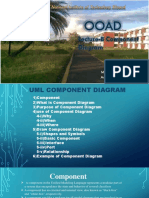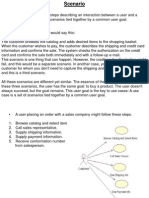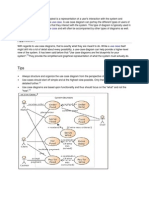Sequence Diagram
Uploaded by
Shehroz AliSequence Diagram
Uploaded by
Shehroz Ali18-1
Partial Design Class Diagram
18-2
Drawing System Sequence Diagrams
System sequence diagram - a diagram that depicts the interaction between an actor and the system for a use case scenario.
helps identify high-level messages that enter and exit the system
10-3
Design Use Case
18-4
Design Use Case (continued)
18-5
Design Use Case (continued)
18-6
Design Use Case (concluded)
18-7
System Sequence Diagram Notations
1. 2.
3.
4.
Actor - the initiating actor of the use case is shown with the use case actor symbol. System the box indicates the system as a "black box" or as a whole. Lifelines the dashed vertical lines extending downward from the actor and system symbols, which indicate the life of the sequence. Activation bars the bars set over the lifelines indicate period of time when participant is active in the interaction.
10-8
System Sequence Diagram Notations (cont.)
5.
6. 7.
Input messages - In parentheses include parameters, following same naming convention and separated with commas. Output messages return messages. Frame These can show loops, alternate fragments, or optional steps.
10-9
Guidelines for Constructing System Sequence Diagrams
Identify which scenario of use case you will depict. So more important to clearly communicate a single scenario. Draw a rectangle representing the system as a whole and extend a lifeline under it. Identify each actor who directly provides an input to the system or directly receives an output from the system. Extend lifelines under the actor(s). Examine use case narrative to identify system inputs and outputs. Draw each external message as a horizontal arrow from the actor's lifeline to the system or from the system to the actor. Label inputs according to UML convention. Add frames to indicate optional messages with conditions. Frames can also indicate loops and alternate fragments. Confirm that the messages are shown in the proper sequence from top to bottom.
10-10
Types of Design Classes
Entity Class - contains business related information
Interface Class - provides the means by which an actor interacts with the system.
A window, dialogue box, or screen. For nonhuman actors, an application program interface (API).
Control Class - contains application logic. Persistence Class - provides functionality to read and write to a database. Structuring the system this way makes the maintenance and enhancement of those classes simpler and easier
18-11
Modeling Class Interactions, Behaviors, and States
Step 1: Identify and Classify Use-Case Design Classes
Step 2: Identify Class Attributes
Step 3: Identify Class Behaviors and Responsibilities
Step 4: Model Object States
Step 5: Model Detailed Object Interactions
18-12
Step 1: Identify and Classify Use-Case Design Classes
Interface, Control, and Entity Classes of Place New Order Use Case
Interface Classes
W00-Member Home Page W02-Member Profile Display W03-Display Order Summary W04-Display Order Confirmation W09-Member Account Status Display W11-Catalog Display W15-Product Detail Display
Controller Classes Place New Order Handler
18-13
Entity Classes Billing Address Shipping Address Email Address Active Member Member Order Member Ordered Product Product Title Audio Title Game Title Video Title Transaction
Step 3: Identify Class Behaviors and Responsibilities
Analyze use cases to identify required system behaviors
Search for verb phrases Some will reflect manual actions, others automated
Associate behaviors and responsibilities with classes Model classes that have complex behavior Examine class diagram for additional behaviors Verify classifications
18-14
Tools for Identifying Behaviors and Responsibilities
Sequence diagram - a UML diagram that models the logic of a use case by depicting the interaction of messages between objects in time sequence.
18-15
CRC Card Listing Behaviors and Collaborators of a Class
Object Name: Member Order
Sub Object:
Super Object: Transaction Behaviors and Responsibilities Report order information Calculate subtotal cost Calculate total order cost Update order status Create Ordered Product Delete Ordered Product
18-16
Collaborators Member Ordered Product
Sequence Diagram
1. 2. 3. 4. 5.
Actor Interface class Controller class Entity classes Messages
6. 7. 8. 9.
Activation bars Return messages Self-call Frame
18-17
Another Sequence Diagram
18-18
Guidelines for Constructing Sequence Diagrams
18-19
Identify the scope of the sequence diagram, whether entire use-case scenario or one step. Draw actor and interface class if scope includes that. List use-case steps down the left-hand side. Draw boxes for controller class and each entity class that must collaborate in the sequence Add persistence if scope includes that. Draw messages and point each to class that will fulfill the responsibility. Add activation bars to indicate object instance lifetimes. Add return messages as needed for clarity. Add frames for loops, optional steps, alternate steps, etc.
Additional UML Design and Implementation Diagrams
Communication diagram - models the interaction of objects via messages, focusing on the structural organization of objects in a network format.
Also known as collaboration diagram
18-20
Communication Diagram
1.
2. 3. 4.
Class Messages Self-calls Numbering scheme - messages should be numbered with a nested scheme.
18-21
What is different?
A communication diagram is similar to a sequence diagram. But while a sequence diagram focuses on the timing or sequence of messages, a communication diagram focuses on the structural organization of objects in a network format. Sequence diagrams are generally better when you want to emphasize the sequence of calls. Communication diagrams are better when you want to emphasize the links. And they are easier when brainstorming alternative solutions.
18-22
You might also like
- Capstone Presentation: Telecom Churn Study100% (3)Capstone Presentation: Telecom Churn Study19 pages
- The Elements of UML Style (Ambler 2002-11-18) (25AE192E)No ratings yetThe Elements of UML Style (Ambler 2002-11-18) (25AE192E)162 pages
- Lab#3 Introduction To UML and Use Case Diagram: ObjectiveNo ratings yetLab#3 Introduction To UML and Use Case Diagram: Objective7 pages
- Using Data Flow Diagrams: Kendall & Kendall Systems Analysis and DesignNo ratings yetUsing Data Flow Diagrams: Kendall & Kendall Systems Analysis and Design49 pages
- Conceptual Design: Uml Class Diagram RelationshipsNo ratings yetConceptual Design: Uml Class Diagram Relationships35 pages
- The Software Development Life Cycle Phases and MethodologiesNo ratings yetThe Software Development Life Cycle Phases and Methodologies84 pages
- Software Engineering and Project ManagementNo ratings yetSoftware Engineering and Project Management23 pages
- COMP 2710 Software Construction: Class Diagrams100% (1)COMP 2710 Software Construction: Class Diagrams13 pages
- MIT 820 Architectures For Software Systems and EmergingNo ratings yetMIT 820 Architectures For Software Systems and Emerging26 pages
- Willowbrook School System Analysis and Design Case SolutionNo ratings yetWillowbrook School System Analysis and Design Case Solution6 pages
- UNIT III Design and Architecture Part IINo ratings yetUNIT III Design and Architecture Part II94 pages
- UML - Use Case Diagram - Tutorial With Examples100% (1)UML - Use Case Diagram - Tutorial With Examples23 pages
- BC0057 - Object Oriented Analysis and DesignNo ratings yetBC0057 - Object Oriented Analysis and Design8 pages
- Identifying Use Cases - Object Analysis - ClassificationNo ratings yetIdentifying Use Cases - Object Analysis - Classification147 pages
- Where can buy (eBook PDF) Management Information Systems: Managing the Digital Firm, Global Edition 16th Edition ebook with cheap price100% (1)Where can buy (eBook PDF) Management Information Systems: Managing the Digital Firm, Global Edition 16th Edition ebook with cheap price55 pages
- Robot Stories and More Screenplays by Greg PakNo ratings yetRobot Stories and More Screenplays by Greg Pak30 pages
- Dynamic Analysis and Design of Tracked Vehicles: Case Study IINo ratings yetDynamic Analysis and Design of Tracked Vehicles: Case Study II47 pages
- Oryentasyon para Sa "Philippine National Public Key Infrastructure" (Pnpki)No ratings yetOryentasyon para Sa "Philippine National Public Key Infrastructure" (Pnpki)24 pages
- Transmission Network Design and Architecture Guidelines Version 1 3No ratings yetTransmission Network Design and Architecture Guidelines Version 1 364 pages
- Driver Drowsiness Detection System Using Image ProcessingNo ratings yetDriver Drowsiness Detection System Using Image Processing6 pages
- West Hollywood Chamber of Commerce Newsletter Fall 2010No ratings yetWest Hollywood Chamber of Commerce Newsletter Fall 201016 pages
- Flight Mode Annunciators (FMAS) : Menu Menu Menu Menu Menu MenuNo ratings yetFlight Mode Annunciators (FMAS) : Menu Menu Menu Menu Menu Menu24 pages
- Division of Electrical, Electronics, and Computer Sciences (EECS) Indian Institute of Science, BangaloreNo ratings yetDivision of Electrical, Electronics, and Computer Sciences (EECS) Indian Institute of Science, Bangalore2 pages
- Book Title:-Inorganic Chemistry For JEE (Advanced) : Part 1: OverviewNo ratings yetBook Title:-Inorganic Chemistry For JEE (Advanced) : Part 1: Overview3 pages
- Sample Technical Report: Measurement and ErrorNo ratings yetSample Technical Report: Measurement and Error10 pages
- The Elements of UML Style (Ambler 2002-11-18) (25AE192E)The Elements of UML Style (Ambler 2002-11-18) (25AE192E)
- Lab#3 Introduction To UML and Use Case Diagram: ObjectiveLab#3 Introduction To UML and Use Case Diagram: Objective
- Using Data Flow Diagrams: Kendall & Kendall Systems Analysis and DesignUsing Data Flow Diagrams: Kendall & Kendall Systems Analysis and Design
- Conceptual Design: Uml Class Diagram RelationshipsConceptual Design: Uml Class Diagram Relationships
- The Software Development Life Cycle Phases and MethodologiesThe Software Development Life Cycle Phases and Methodologies
- MIT 820 Architectures For Software Systems and EmergingMIT 820 Architectures For Software Systems and Emerging
- Willowbrook School System Analysis and Design Case SolutionWillowbrook School System Analysis and Design Case Solution
- Identifying Use Cases - Object Analysis - ClassificationIdentifying Use Cases - Object Analysis - Classification
- Java Reflection Complete Self-Assessment GuideFrom EverandJava Reflection Complete Self-Assessment Guide
- Time series database A Clear and Concise ReferenceFrom EverandTime series database A Clear and Concise Reference
- Oracle CRM On Demand Administration EssentialsFrom EverandOracle CRM On Demand Administration Essentials
- Where can buy (eBook PDF) Management Information Systems: Managing the Digital Firm, Global Edition 16th Edition ebook with cheap priceWhere can buy (eBook PDF) Management Information Systems: Managing the Digital Firm, Global Edition 16th Edition ebook with cheap price
- Dynamic Analysis and Design of Tracked Vehicles: Case Study IIDynamic Analysis and Design of Tracked Vehicles: Case Study II
- Oryentasyon para Sa "Philippine National Public Key Infrastructure" (Pnpki)Oryentasyon para Sa "Philippine National Public Key Infrastructure" (Pnpki)
- Transmission Network Design and Architecture Guidelines Version 1 3Transmission Network Design and Architecture Guidelines Version 1 3
- Driver Drowsiness Detection System Using Image ProcessingDriver Drowsiness Detection System Using Image Processing
- West Hollywood Chamber of Commerce Newsletter Fall 2010West Hollywood Chamber of Commerce Newsletter Fall 2010
- Flight Mode Annunciators (FMAS) : Menu Menu Menu Menu Menu MenuFlight Mode Annunciators (FMAS) : Menu Menu Menu Menu Menu Menu
- Division of Electrical, Electronics, and Computer Sciences (EECS) Indian Institute of Science, BangaloreDivision of Electrical, Electronics, and Computer Sciences (EECS) Indian Institute of Science, Bangalore
- Book Title:-Inorganic Chemistry For JEE (Advanced) : Part 1: OverviewBook Title:-Inorganic Chemistry For JEE (Advanced) : Part 1: Overview

























































































